Vintage 1970s Photos Show Lost Sites of NYC's Lower East Side
A quest to find his grandmother's birthplace led Richard Marc Sakols on a mission to capture his changing neighborhood on film.


What could be more enticing than an exhibition entitled Carnal Knowledge: Sex + Philosophy? Not much, especially when said exhibition features works by Marcel Duchamp, Man Ray and (my personal favorite) Sophie Calle. Understandably, my expectations for this show were high.
Yet, the exhibition isn’t nearly as juicy as one would expect from the title. The artworks, arranged in typical Chelsea fashion on blank walls in an otherwise empty space, seem almost cold and cerebral. This might seem like a harsh criticism, but perhaps that’s the point: to present works of art that question the intellectual discourse surrounding sexuality. Immediately upon entering the gallery, one sees a series of imprinted drawings by Agnes Denes, in which a sex organ has been stamped onto a piece of graph paper like a fingerprint. In one drawing, a breast sits placidly under the type of gridded sphere we used to draw in geometry class. Another drawing, titled Investigation of World Rulers: “Napoleon Overlooking the Elba”, shows penises stamped onto the paper in a row almost like a graph. This incongruous marriage of sex and geometry seems strange or absurd, but according to the curators seeks to “insert the body and its amorous instruments directly into the grid-like matrix of the rational.” The very phrase “amorous instruments” draws attention to the sometimes mechanical motions of our own bodies.
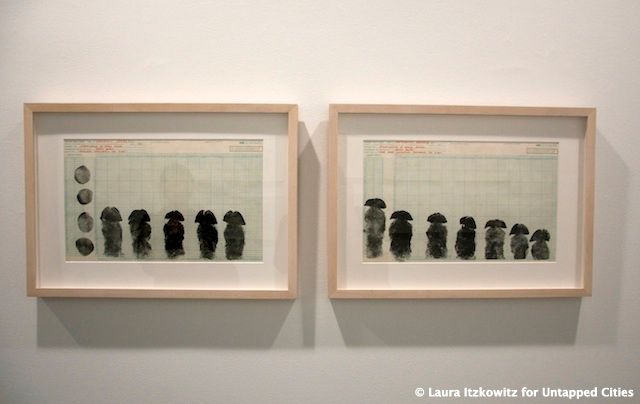 Investigation of World Rulers: “Napoleon Overlooking the Elba” from the Napoleonic Series I, 1971 (left) and Investigation of World Rulers: “Some More Napoleons Overlooking the Elba” from the Napoleonic Series II, 1971 (right) by Agnes Denes
Investigation of World Rulers: “Napoleon Overlooking the Elba” from the Napoleonic Series I, 1971 (left) and Investigation of World Rulers: “Some More Napoleons Overlooking the Elba” from the Napoleonic Series II, 1971 (right) by Agnes Denes
If Denes references geometry in her drawings, the other artists in the exhibition reference more creative domains such as literature and art history. Both Man Ray and Paul Chan reference the Marquis de Sade. In Man Ray’s Imaginary Portrait of the Marquis de Sade, a rather cruel-looking man made of stone gazes at a castle in the background. For The body of Oh there is no one one (truetype font), Paul Chan created a functional font from the Marquis de Sade’s writings. Though the letters are clear and bold, the ink drips down the page in places, reminding us of the sometimes messy and uncontrollable nature of the human body.
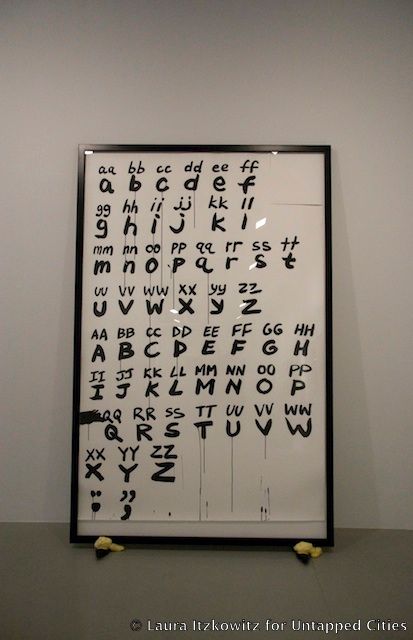 The body of Oh there is no one one (truetype font) by Paul Chan.
The body of Oh there is no one one (truetype font) by Paul Chan.
However, the most direct reference to a great artist who challenged the societal discourse on sexuality comes from Sherrie Levine and Anna Ostoya, both of whom re-present Courbet’s L’Origine du Monde in a new way. Levine framed a series of postcards from the Musée D’Orsay and lined them up in perfectly geometrical rows so the image is repeated eighteen times. Ostoya, on the other hand, sought to distort Courbet’s painting by re-creating it in a style that seems to be a cross between Cubism and the type of pixellation you see on computer graphics. The planes of flesh and fabric you see in Courbet’s original have become rough and jagged due to the superimposition of geometric shapes. The effect is almost like looking at L’Origine du Monde through a kaleidoscope. Levine and Ostoya remind us what an incredible influence Courbet had on the history of art in the Western world. Before photography made it easy to frame a subject, Courbet composed a painting which sought to valorize that which was considered dirty.
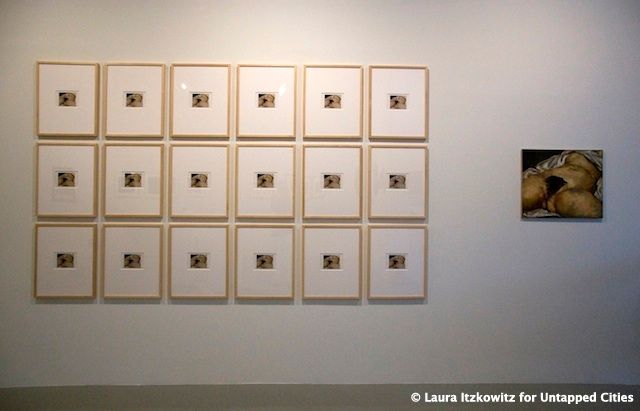 After Courbet 1-18 (2009) by Sherrie Levine (left) and The Origin/The End by Anna Ostoya (right)
After Courbet 1-18 (2009) by Sherrie Levine (left) and The Origin/The End by Anna Ostoya (right)
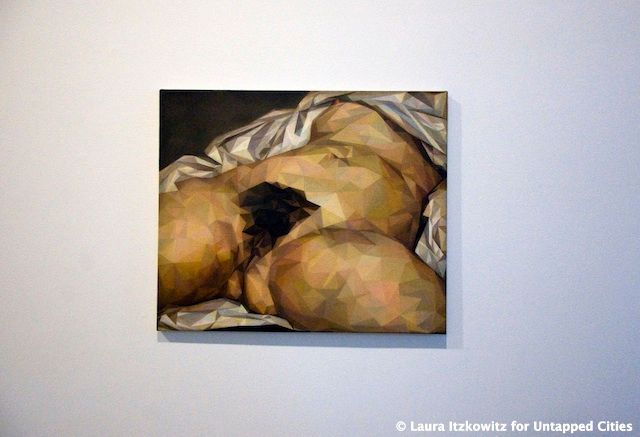 The Origin/The End by Anna Ostoya
The Origin/The End by Anna Ostoya
Sophie Calle brings the emotion back into this rather cerebral exhibition. The gallery only features one tiny selection from Appointment with Sigmund Freud (originally installed in situ at the Freud Museum, London), but her words send a more distinct message than many of the other works featured in the show. A miniature die sits in the type of little red box that normally holds an engagement ring. Embossed on the top in gold lettering is the anecdote about how Calle asked her lover to make arbitrary decisions for her, and when he left her, he gave her a pair of dice which she could use to make decisions in his absence. For anyone familiar with Calle’s oeuvre, this selection seems less obvious than some of her pieces that muse on her sexuality more explicitly. However, in the context of the exhibition, the die ties the emotional to the rational in the attempt to privilege the rational over the emotional.
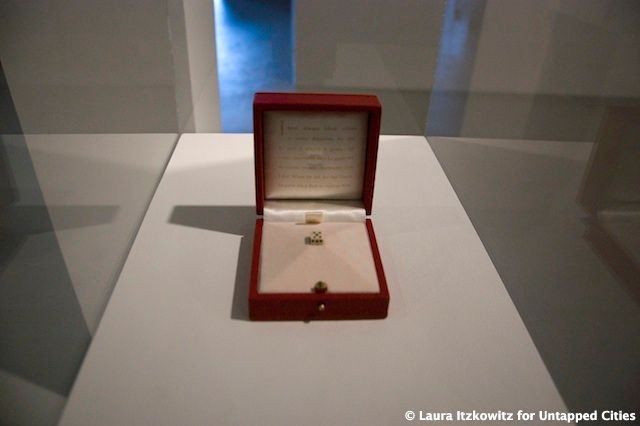 Selection from Appointment with Sigmund Freud by Sophie Calle
Selection from Appointment with Sigmund Freud by Sophie Calle
Finally, Marcel Duchamp’s Boîte Alerte — Missives Lascives brings a bit of humor back into the equation.
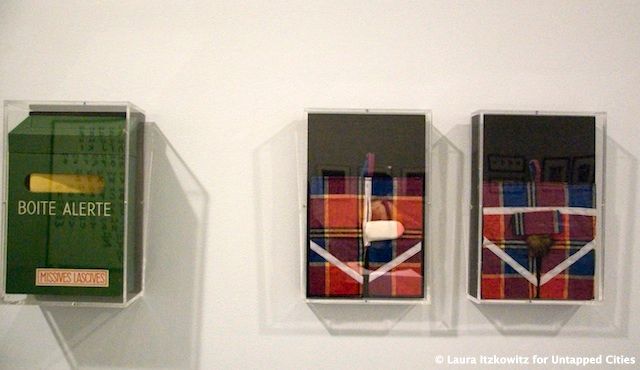 Boîte Alerte — Missives Lascives, 1959 by Marcel Duchamp
Boîte Alerte — Missives Lascives, 1959 by Marcel Duchamp
Carnal Knowledge: Sex + Philosophy provokes us to rethink our expectations about sexuality in art and reflect on the long tradition of thinkers who sought to change the way society talks about sex. The exhibition will remain on view until July 27.
Leslie Tonkonow Artworks + Projects [map]
535 West 22nd Street
New York, NY 10011
(212) 255-8450
Get in touch with the author @lauraitzkowitz
Subscribe to our newsletter